Related Research Articles
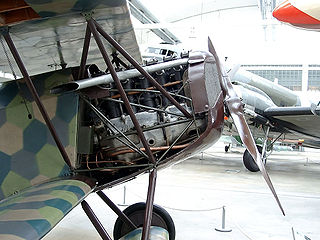
The Mercedes D.III, or F1466 as it was known internally, was a six-cylinder SOHC valvetrain liquid-cooled inline aircraft engine built by Daimler and used on a wide variety of German aircraft during World War I. The initial versions were introduced in 1914 at 160 hp, but a series of changes improved this to 170 hp in 1917, and 180 by mid-1918. These later models were used on almost all late-war German fighters, and its only real competition, the BMW III, was available only in very limited numbers. Compared to the Allied engines it faced, the D.III was generally outdated.
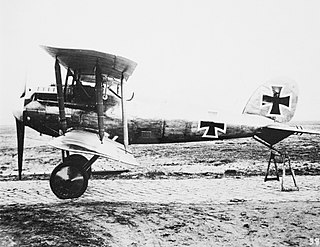
The Albatros D.VII was a German prototype single-seat fighter biplane flown in August 1917. It was powered by a water-cooled Benz Bz.IIIb V8 engine developing 145 kW (195 hp) and armed with two 7.92 mm (.312 in) machine guns. The D.VII had ailerons on both upper and lower wings linked by hinged struts.

The Albatros Dr.II was a German prototype single-seat fighter triplane, the sole example of which flew in the spring of 1918. It was similar in many respects to the D.X biplane, employing among other features the same 145 kW (195 hp) Benz Bz.IIIbo engine and twin 7.92 mm (.312 in) machine guns.
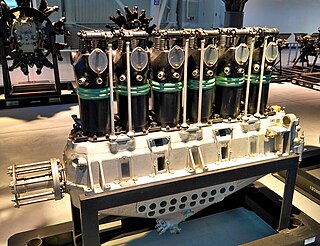
The Benz Bz.IV was a German six-cylinder, water-cooled, inline engine developed for aircraft use. Deliveries began in 1916, and some 6,400 were produced.
The Mercedes D.I was a six-cylinder, water-cooled, SOHC valvetrain inline engine developed in Germany for use in aircraft in 1913. Developing 75 kW (100 hp), it powered many German military aircraft during the very early part of World War I.
The Benz Bz.III was a six-cylinder, water-cooled, inline engine developed in Germany for use in aircraft in 1914. Developing 112 kW (150 hp) at 1,400 rpm from 14.3 L, it powered many German military aircraft during World War I. It was replaced in production by the unrelated Benz Bz.IIIa. and eventually the V-8 Benz Bz.IIIb. The Benz Bz.III was built under licence in Sweden by AB Thulinverken, known as the Thulin E.
The Benz Bz.II was a six-cylinder, water-cooled, inline engine developed in Germany for use in aircraft in 1913. With a displacement of 10.15 L (619.4 cu in) it developed about 75–82 kW (100–110 hp). It had cast-iron cylinders with sheet metal cooling jackets welded to them. The two overhead valves per cylinder were operated via pushrods and rocker arms by a single camshaft embedded in the engine block on the right-hand side.
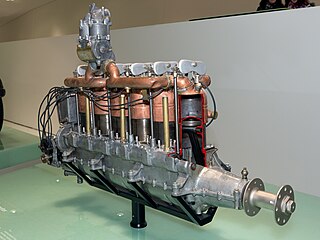
The Austro-Daimler 6 was a series of Austrian six-cylinder water-cooled inline aero engines first produced in 1910 by the Austro-Daimler company.

The Hansa-Brandenburg CC was a single-seat German fighter flying boat of World War I. It was used by both the Kaiserliche Marine and the Austro-Hungarian Navy.

The Roland D.VI was a German fighter aircraft built at the end of World War I. It lost a fly-off to the Fokker D.VII, but production went ahead anyway as insurance against problems with the Fokker.

The LFG Roland D.II was a German single-seat fighter of World War I. The type was manufactured by Luftfahrzeug Gesellschaft, and also by Pfalz Flugzeugwerke under license.

The LFG Roland D.I was a fighter aircraft produced in Germany during World War I. It was a single-seat aircraft based originally on the Roland C.II two-seat reconnaissance type. It shared its predecessor's unusual design feature of having a deep fuselage that completely filled the interplane gap, but in comparison, the fuselage was much sleeker. While the C.II's appearance had earned the Walfisch ("Whale"), the D.I became known as the Haifisch ("Shark"). The I-struts that had been used to brace the C.II's wing were replaced by more conventional struts. Other changes to the wing included the removal of stagger from the design and the introduction of slight sweepback.

The LFG Roland D.III was a fighter aircraft produced in Germany during World War I.

The Aviatik D.III was a German prototype single-seater fighter plane from the First World War, designed by Aviatik. It became the basis for the Aviatik D.IV and Aviatik D.V. In November 1917, the plane was first flown, using a 195 hp Benz Bz IIIbo gearless engine. It was of similar design to the Aviatik D.II, and was armed with two LMG 08/15 machine guns. After several tests at Adlershof from February 9–12, 1918, the plane underwent modifications, as requested by the Idflieg. In April, a second prototype, powered by a Benz Bz IIIbm, although several D.III powered by the original IIIbo engine were already under production; however, none of them were ever completed.

The Luft-Fahrzeug-Gesellschaft (LFG) Roland D.VII was a German single seat, single engine biplane fighter aircraft built during World War I. Problems with its underdeveloped V-8 engine prevented its production.

The LFG Roland D.IX was a World War I German single seat fighter aircraft, a biplane powered by one of a new generation of powerful rotary engines. Three slightly different prototypes were built but there was no series production.

The LFG Roland D.XV was a World War I German single seat fighter aircraft, ordered as a test-bed for engine comparisons. It was distinguished from earlier Roland biplane designs by the elimination of flying wires. Two later aircraft, also called LFG Roland D.XV, were completely different designs with slab sided fuselages.

The LFG Roland D.XVI, initially designated the LFG Roland E.I, was a single-seat, single-engine, parasol wing German fighter aircraft flown close to the end of World War I. Only two were built.
The Daimler D.IIIb was a V-8, water-cooled, piston engine developed in Germany by Daimler Motoren Gesellschaft, for use in aircraft in 1918.
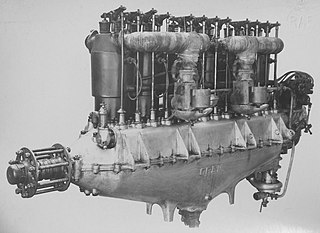
The Argus As III was a six-cylinder, in-line, water-cooled, aircraft engine produced in Germany by Argus Motoren during World War I. The Argus As III produced 180 hp (130 kW) at 1,400 rpm.
References
- Gunston, Bill (1986). World Encyclopedia of Aero Engines. Wellingborough: Patrick Stephens. p. 25.
- Green, William; Swanborough, Gordon (1994). The Complete Book of Fighters. Godalming, UK: Salamander Books. p. 339. ISBN 1-85833-777-1.
- "Century of Flight". Archived from the original on 25 December 2010. Retrieved 30 June 2013.
| | This aircraft engine article is missing some (or all) of its specifications. If you have a source, you can help Wikipedia by adding them. |